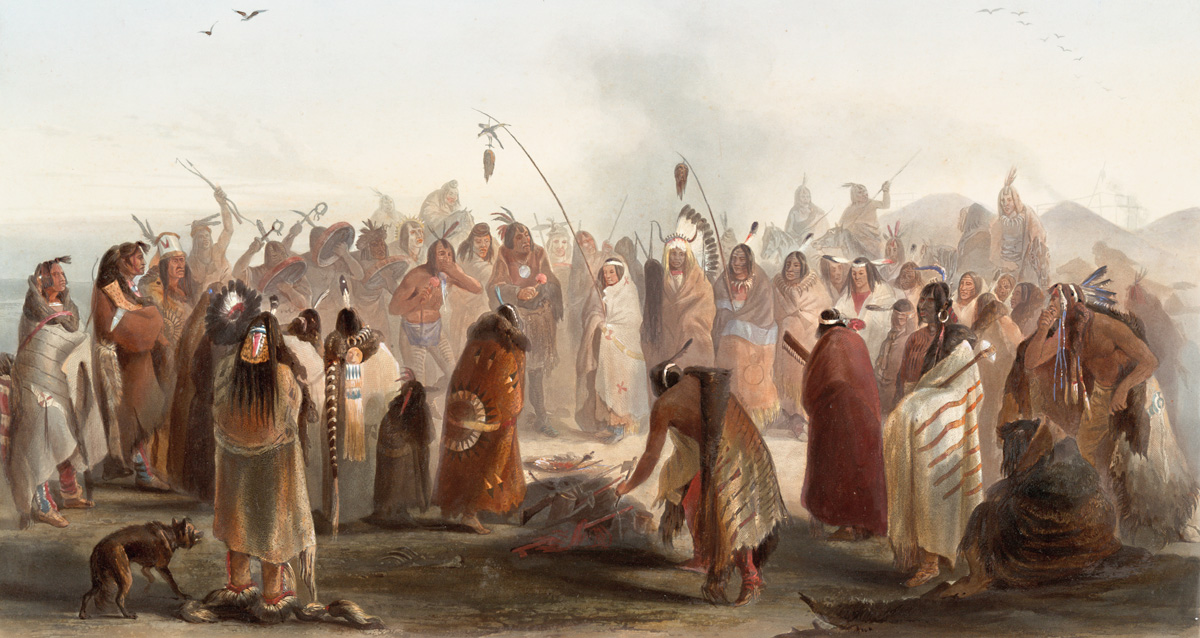Among the Lakotas near present Pierre, South Dakota, an anchor line is accidentally severed, and the men must act quickly to save the barge. The Lakotas think they are under attack, and the captains suspect the Sioux are forming their own attack. Sgt. Gass describes the Scalp Dance.
The Troublesome Tetons
by Yellowstone Public Radio[1]Originally aired weekdays by Yellowstone Public Radio during the Bicentennial observance of 2003-2006. Narrated by Hal Hansen. Scripts by Whit Hansen and Ed Jacobson. Produced by Leni Holliman. © … Continue reading
Losing the Anchor
when we came on board an axedant happened by running the perogue across the bow of the boat and broke our cable and lost our anker all hands was raised and roed the barge to Shore. the Savages ran down to know what was the matter. we told them they Said that they came to our assistance we thanked them for Showing their good will but kept on our guard all night for fear they would turn our enimies themselves.
—Joseph Whitehouse
Scalp Dance
Scalp Dance of the Minatarres
by Karl Bodmer (1809–1893)
Rare Book Division, The New York Public Library.[2]“Scalptanz der Mönnitarris. Danse du scalp des indiens Meunitarris. Scalp dance of the Minatarres.” New York Public Library Digital Collections. Accessed 5 March 2019. … Continue reading
Their band of musick, or orchestra, was composed of about twelve persons beating on a buffaloe hide, and shaking small bags that made a rattling noise [thrapples]. They had a large fire in the centre of their camp; on one side the women, about 80 in number, formed in a solid column round the fire, with sticks in their hands, and the scalps of the Mahas [Omahas] they had killed, tied on them.
—Patrick Gass
Scalp dances were common among many nations. Above, Bodmer depicts such a dance from the Hidatsas circa 1832. At that time, these Siouan-speaking Peoples were called Minatarres, Gros Ventres, and Big Bellies.
Suspicions Abound
we had every reason to believe from ther Conduct intended to make an attempt to Stop our progress & if possible rob us— Peter Crusat [Pierre Cruzatte] who Spoke Mahar came in the night and informed me that the mahar Prisoners told him that the Tetons intended to Stop us— We Shew’d but little Sign of a knowledge of there intentions.
—William Clark
Weather Diary
Thermot. at rise
Weather Wind at rise
thermotr. at 4 P.M. Weather Wind at 4 oC. P.M 52 fair W. 86 fair S. W. Saw a large flock of white Gulls with wings tiped with black
—Meriwether Lewis[3]To assist the reader, the editor of this web page has omitted the “day of the month” column and spelled out some abbreviations.
Bad River Encounter Site is a High Potential Historic Site along the Lewis and Clark National Historic Trail managed by the U.S. National Park Service. The site is located in Fischers Lilly Park of the city of Fort Pierre.
Notes
| ↑1 | Originally aired weekdays by Yellowstone Public Radio during the Bicentennial observance of 2003-2006. Narrated by Hal Hansen. Scripts by Whit Hansen and Ed Jacobson. Produced by Leni Holliman. © 2003 by Yellowstone Public Radio. |
|---|---|
| ↑2 | “Scalptanz der Mönnitarris. Danse du scalp des indiens Meunitarris. Scalp dance of the Minatarres.” New York Public Library Digital Collections. Accessed 5 March 2019. http://digitalcollections.nypl.org/items/510d47da-c450-a3d9-e040-e00a18064a99. |
| ↑3 | To assist the reader, the editor of this web page has omitted the “day of the month” column and spelled out some abbreviations. |
Experience the Lewis and Clark Trail
The Lewis and Clark Trail Experience—our sister site at lewisandclark.travel—connects the world to people and places on the Lewis and Clark Trail.
Discover More
- The Lewis and Clark Expedition: Day by Day by Gary E. Moulton (University of Nebraska Press, 2018). The story in prose, 14 May 1804–23 September 1806.
- The Lewis and Clark Journals: An American Epic of Discovery (abridged) by Gary E. Moulton (University of Nebraska Press, 2003). Selected journal excerpts, 14 May 1804–23 September 1806.
- The Lewis and Clark Journals. by Gary E. Moulton (University of Nebraska Press, 1983–2001). The complete story in 13 volumes.




